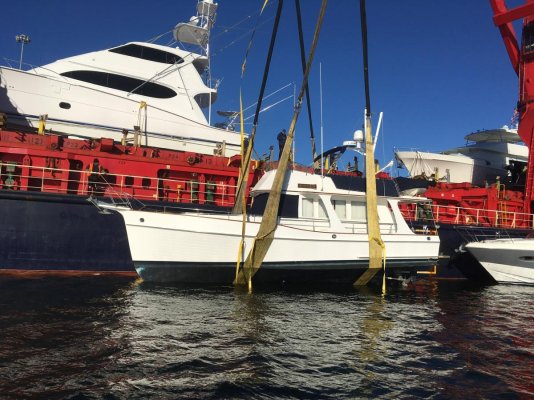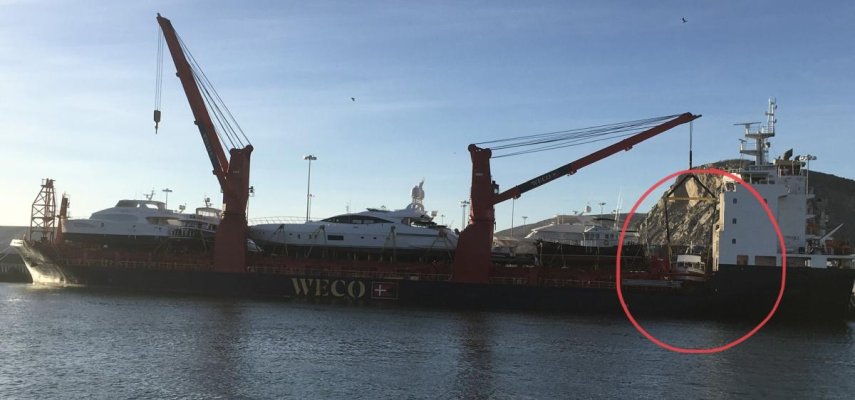rsn48
Guru
- Joined
- Feb 18, 2019
- Messages
- 2,019
- Location
- Canada
- Vessel Name
- Capricorn
- Vessel Make
- Mariner 30 - Sedan Cruiser 1969
I thought I would include my curious ramblings into boat transportation. I don't know why, I don't plan to ship my boat anywhere. But where I used to live in North Vancouver (Deep Cove), was the final destination for those ships that would sink, bring on the yachts, blow ballasts and rise, cruise from Florida to North Vancouver, blow ballasts and sink, then let the boats float off. So I have paid mild attention to moving boats from long distant points.
Secondly I am a model railroader with all the baggage that entails, including following favourite prototypes, learning how things are shipped, etc. I will throw in a bonus link if you are bored and have no life right now.
So the standard model of transportation is thusly: 1) Item sent on a ship (usually in a container, but could be in "break bulk") 2) then said item transferred from ship to freight train 3) then from freight train to truck. Thus items could be shipped to Vancouver from China, said item loaded unto a CN freight train and sent to Florida, then off loaded unto a truck for its final short journey.
Trains are efficient. Think about it, you put your boat on a trailer and a truck dedicated only to that trailer carries it across country. Or your boat is put on one of those sinking ships, but they only carry maybe thirty or less boats. Or you could put your boat on a train car dedicated to unusual loads, and that car along with hundreds of others traverse the country pulled by four or five engines.
So I did a quick google and came up with this one railroad link, but I have wondered how the pricing would go using it versus other modes of transportation.
Boat Shipping by Train
Bonus link for the very bored. Most don't know that Rod Stewart (Yes, that Rod Stewart) is an avid model railroader (so was Frank Sinatra and other well known celebrities). In fact Rod is considered one of the best modelers in the railway community. Turns out he is colour blind so others have to do the landscaping, he discovered this once when installing grass on the layout and his friends wanted to know why he laid red grass.... lol... his story, not mine. So with the pictures I'm going to link you to, he built them all except the bridge you might see)
Secondly I am a model railroader with all the baggage that entails, including following favourite prototypes, learning how things are shipped, etc. I will throw in a bonus link if you are bored and have no life right now.
So the standard model of transportation is thusly: 1) Item sent on a ship (usually in a container, but could be in "break bulk") 2) then said item transferred from ship to freight train 3) then from freight train to truck. Thus items could be shipped to Vancouver from China, said item loaded unto a CN freight train and sent to Florida, then off loaded unto a truck for its final short journey.
Trains are efficient. Think about it, you put your boat on a trailer and a truck dedicated only to that trailer carries it across country. Or your boat is put on one of those sinking ships, but they only carry maybe thirty or less boats. Or you could put your boat on a train car dedicated to unusual loads, and that car along with hundreds of others traverse the country pulled by four or five engines.
So I did a quick google and came up with this one railroad link, but I have wondered how the pricing would go using it versus other modes of transportation.
Boat Shipping by Train
Bonus link for the very bored. Most don't know that Rod Stewart (Yes, that Rod Stewart) is an avid model railroader (so was Frank Sinatra and other well known celebrities). In fact Rod is considered one of the best modelers in the railway community. Turns out he is colour blind so others have to do the landscaping, he discovered this once when installing grass on the layout and his friends wanted to know why he laid red grass.... lol... his story, not mine. So with the pictures I'm going to link you to, he built them all except the bridge you might see)


